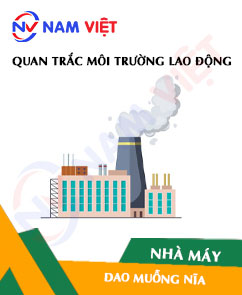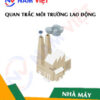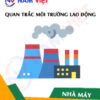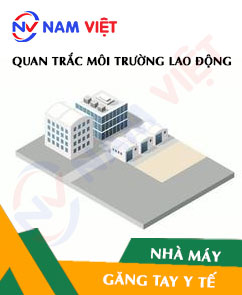Occupational Environment Monitoring at Cutlery Manufacturing Factory
99,000 ₫
Note: The above price is calculated per sample and may vary depending on the area of the environment to be monitored and market fluctuations. For more accurate pricing support, please refer to the price list or contact our consulting staff directly.
Monitoring the environment of a cutlery production factory is a session for collecting, analyzing, and evaluating workplace factors that may be harmful to workers’ health.
Table of Contents
Toggle1. Overview of Cutlery Manufacturing Factory
a. What is a cutlery manufacturing factory?
Manufacturing factory for cutlery is a production facility specializing in manufacturing various knives, spoons, forks, and other dining utensils. At this factory, production processes are conducted to create high-quality cutlery products to meet the needs of households, restaurants, hotels, and other dining establishments. Production stages include material processing, shaping, forging, surface treatment, assembly, and quality inspection.

b. Production stages in a cutlery manufacturing factory
The production stages in a cutlery manufacturing factory may include:
- Material processing: Materials used to manufacture cutlery, such as stainless steel, are processed into thin sheets with the required size and shape.
- Shaping: Material sheets are cut into the initial shapes of knives, spoons, and forks using cutting machines, stamping machines, or CNC cutters.
- Forging: Parts of the cutlery are forged to create precise shapes and structures. The forging process may include hot and cold hammering to shape the products.
- Surface treatment: The surface of the cutlery is processed to achieve a smooth, polished finish or engraved/printed patterns and logos. Surface treatment may include grinding, polishing, color removal, plating, or coating.
- Assembly: Parts of the cutlery are assembled into complete products, including attaching handles, securing components, and checking alignment and sturdiness.
- Quality inspection: Cutlery products are inspected to ensure they meet standards for sharpness, durability, and safety. Inspections may include hardness testing, sharpness checking, and mechanical durability testing.
- Packaging: Cutlery products are safely packaged to protect them during transportation and storage. Packaging may include placing them in boxes, wrapping with foam, or using other protective materials.

c. Types of machinery used in a cutlery manufacturing factory
In a cutlery manufacturing factory, various machines and equipment are used to carry out the production stages. Some commonly used machines include:
- Cutting machines: Used to cut material sheets into the initial shapes of knives, spoons, and forks.
- Stamping machines: Used to shape and form parts of the cutlery by applying compressive force.
- Forging machines: Used to forge and form precise structures for cutlery parts using high pressure and temperature.
- Grinding machines: Used for surface processing to achieve smooth and polished surfaces.
- Polishing machines: Used to enhance brightness and shine of the cutlery parts.
- Color removal machines: Used to remove color or create patterns and special colors on cutlery parts.
- Printing or laser engraving machines: Used to print or engrave logos, patterns, or other information onto the cutlery surfaces.
- Quality inspection machines: Used to test sharpness, hardness, and mechanical durability of cutlery products.

d. Occupational diseases that workers in cutlery manufacturing factories may face
Workers in a cutlery manufacturing factory may be exposed to certain hazardous factors that can cause some occupational diseases. Some common occupational diseases include:
- Cuts and injuries: Due to direct contact with cutting tools and working with sharp materials, workers may be at risk of cuts or injuries.
- Respiratory diseases: Working in dusty environments or with metal fumes from processing may cause respiratory issues such as pneumonia, sinusitis, and other breathing problems.
- Skin diseases: Exposure to chemicals, detergents, or cleaning agents can cause skin irritation, dermatitis, allergies, or infections.
- Hand and wrist disorders: Repetitive tasks and improper handling can cause issues such as wrist inflammation, hand numbness, or cervical spine degeneration.
- Accident-related injuries: While operating machinery and equipment, there is a risk of collisions, falls, crushing, entrapment, or puncture injuries.
To prevent and reduce these risks, cutlery manufacturing factories should implement occupational safety measures, ensure worker safety, and protect health, including providing protective equipment, safety training, workplace monitoring, and safe work procedures.

e. Common types of cutlery in the market
There are many types of cutlery available in the market, each with its own features and applications. Some popular types include:
- Standard cutlery: Used daily in households and restaurants, typically with small blades attached to handles, suitable for eating grilled dishes, salads, and other foods.
- Steak cutlery set: Specifically designed for eating beef, usually with thick and hard blades for easy cutting and chewing.
- Sushi cutlery set: Used in Japanese cuisine, with compact, sharp blades suitable for cutting and eating sushi, sashimi, and other Japanese dishes.
- Tea or dessert cutlery set: Used for tea parties or dessert, usually small in size, made from premium materials like sterling silver or stainless steel.
- Decorative cutlery set: Used for food decoration or shaping dishes, often with special blades to create complex patterns on food.
- Serving cutlery set: Used in restaurants and hotels to serve guests, with large sizes and wide blades for easy food serving.

2. Overview of Occupational Environment Monitoring Services
a. What is occupational environment monitoring in a cutlery manufacturing factory?
Occupational environment monitoring (or workplace environmental measurement) in a cutlery manufacturing factory involves collecting, evaluating, and analyzing measurements of workplace environmental factors to implement timely measures, reduce environmental harm to workers’ health, and prevent occupational diseases. Occupational environment monitoring is a mandatory requirement for cutlery manufacturing factories.
Occupational environment monitoring plays a crucial role in caring for, protecting, and enhancing workers’ health, as workers are the main resource of a business and directly generate profit. Workers regularly exposed to hazardous factors exceeding permissible limits can be affected health-wise and develop occupational diseases.
REGISTER FOR OCCUPATIONAL ENVIRONMENT MONITORING SERVICE
b. Nam Viet’s occupational environment monitoring program
Nam Viet’s occupational environment monitoring program is designed by engineers specialized in occupational safety and environmental protection. With the goal of ensuring worker health and safety, the program uses modern measurement methods to monitor air, water, microclimate, physical factors, dust, and other workplace environmental conditions. This program is vital to ensure a safe working environment and protect workers’ health.
Additionally, Nam Viet’s program plays a key role in researching and developing new solutions to improve workplace environmental quality. With a dedicated and professional team of monitoring experts, Nam Viet’s exclusive monitoring program is a breakthrough in occupational safety and environmental management in Vietnam.

c. Standardization in occupational environment measurement procedures
Standardization in Nam Viet’s occupational environment measurement procedures is critical to ensure the quality of measurement results. To ensure accuracy and reliability, the program follows recognized standards and procedures of the Ho Chi Minh City Department of Health. This ensures collected data are highly reliable for evaluating workplace environments and making decisions to improve working conditions and protect workers’ health.
These standardized procedures also ensure that measurements are conducted by a highly skilled team of monitoring specialists with years of experience, giving managers and experts confidence in Nam Viet’s results for informed decision-making on worker health and environmental protection.
By applying standardized measurement procedures, Nam Viet demonstrates its commitment to ensuring a safe working environment, protecting worker health, and contributing positively to the development and enhancement of occupational safety and environmental management in Vietnam.
d. Reporting results of cutlery manufacturing factory monitoring
Occupational environment monitoring results are prepared according to Form No. 04, Appendix III issued with Decree 44/2016/ND-CP and are made in two copies: one sent to the enterprise that signed the monitoring contract and one kept by the monitoring organization.
The retention period for occupational environment monitoring results follows legal regulations: indefinite record storage.

e. Frequency of occupational environment monitoring as required by law
According to Clause 2, Article 18 of the Labor Safety and Hygiene Law 84/2015/QH13, employers must organize occupational environment monitoring to assess harmful factors at least once per year.
f. Deadline for submitting occupational environment monitoring reports as required by law
The deadline for report submission is before December 31 each year. Enterprises in production facilities must submit monitoring reports to the local Department of Health at the location of the enterprise’s head office and where workers are employed.
When there are changes in technology, production processes, or upgrades to facilities that may generate new hazardous factors, enterprises must update occupational hygiene records regarding harmful factors that require monitoring.
g. Penalties for violations of occupational environment monitoring for employers
According to Article 27 of Decree No. 12/2022/ND-CP dated 17/01/2022 on administrative penalties in labor, social insurance, and Vietnamese workers working abroad under contract:
- Clause 2: Fines from VND 2,000,000 to 5,000,000 for employers who do not publicly inform workers at the monitored workplace and evaluation site immediately after receiving monitoring and assessment results of hazardous factors.
- Clause 3: Fines from VND 20,000,000 to 40,000,000 for employers who fail to conduct occupational environment monitoring to control health hazards according to legal regulations.
- Clause 4: Fines from VND 40,000,000 to 60,000,000 for employers who collude with monitoring organizations to commit fraud in occupational environment monitoring activities but not reaching criminal liability.
3. Harmful Environmental Factors for Workers in Cutlery Manufacturing Factories
Some environmental factors that may harm workers in cutlery manufacturing factories include:
- Metal dust and fumes: During the production of spoons, forks, and knives, metal dust and fumes may arise from machining and grinding processes. Prolonged exposure to metal dust and fumes can lead to health issues such as pneumonia, rhinitis, and other respiratory problems.
- Chemicals: Some chemicals such as solvents, cleaning agents, and additives may be used during cutlery production. Long-term exposure to these chemicals can cause skin irritation, respiratory problems, and other health issues.
- Noise: Machining and manufacturing spoons, forks, and knives can generate high noise levels, especially when using cutting and grinding machines. Continuous high-intensity noise can affect hearing and cause stress for workers.
- Temperature and humidity: Certain production processes in cutlery factories can create hot and humid working environments. Such conditions can make it difficult to regulate body temperature, causing fatigue and affecting health.
- Physical working conditions: Work in cutlery manufacturing factories may require standing for long periods, frequent movement, or physical exertion. This can lead to muscle strain, back pain, and issues related to poor posture.
REGISTER FOR OCCUPATIONAL ENVIRONMENT MONITORING SERVICE
4. Measures to Improve the Working Environment in cutlery Manufacturing Factories
To improve the working environment in cutlery manufacturing factories and protect workers’ health, the following measures can be applied:
- Ventilation and exhaust systems: Install ventilation and exhaust systems to remove smoke, dust, and fumes from the machining process. This helps reduce exposure to harmful substances and improves air quality in the factory.
- Use of dust extraction systems: Install effective dust extraction systems to remove metal dust and fumes from grinding operations. This helps reduce exposure to harmful substances and keeps the working environment clean.
- Ensure safe chemical handling procedures: Implement safety measures when working with chemicals, including personal protective equipment (gloves, safety glasses), follow safe storage and handling procedures, and provide chemical safety training for employees.
- Noise management: Provide ear protection to safeguard workers’ hearing in high-noise environments. Additionally, reduce noise using sound insulation, vibration damping, and acoustic barriers for noisy machinery.
- Safety training and supervision: Ensure employees receive occupational safety training and follow safe working procedures. Conduct supervision and risk assessments to identify and minimize health and safety hazards.
- Improve physical working conditions: Provide comfortable and suitable work equipment, such as chairs with backrests, proper lighting, and adjustable-height workbenches. Regularly inspect and maintain machinery to ensure proper operation and prevent accidents.
- Periodically conduct occupational environment monitoring in factories, collect and analyze harmful factors for workers, and adjust measures to reduce hazards and prevent occupational diseases.
5. Benefits of Regular Cutlery Factory Environmental Monitoring
An Toan Nam Viet provides enterprises with excellent benefits when using occupational environment monitoring services in accordance with Decree 44/2016/ND – CP on managing and controlling harmful factors in the working environment affecting workers.
- Enterprises can proactively control harmful factors in workshops or factories.
- Receive professional recommendations to mitigate hazards and improve working environment quality.
- Indirectly protect human resources, a key factor in business development.
- Minimize the impact of occupational diseases on health, reducing future treatment costs.
- Improved worker health leads to better product quality and consistent output.
- Ensure compliance with occupational safety laws and avoid legal risks.
- Enhance enterprise credibility and professionalism, elevating the brand.
Nam Viet’s environmental monitoring service is a solution to reduce occupational disease hazards, contributing to a clean and high-quality working environment.

6. Nationwide Occupational Environment Monitoring Center
Nam Viet Occupational Environment Monitoring Center is a professional unit specializing in monitoring and measuring occupational environment quality across all provinces in Viet Nam. With a team of experienced monitoring specialists, the center uses modern measuring equipment to ensure accuracy and reliability.
In addition to monitoring services, the center assists clients in planning, handling, and tracking occupational environment issues. With the motto “customer-centric,” the center prioritizes client satisfaction, meets all client needs, and commits to providing the best solutions for enterprises.
REGISTER FOR OCCUPATIONAL ENVIRONMENT MONITORING SERVICE
With investment in technology, equipment, and personnel, Nam Viet’s monitoring center has become one of the most reputable units in occupational environment monitoring in Ho Chi Minh City, with the following objectives:
- We always value our brand reputation and the quality of our services.
- We provide clients with the best and most suitable solutions.
- With a team of experienced Masters and Engineers, committed to protecting the environment and benefiting enterprises.
- Clients using Nam Viet Environmental Monitoring will receive professional service from experts in the field, along with the best cost advantages.
The occupational environment monitoring process at Nam Viet includes the following basic steps:
- Before conducting monitoring, we ensure that all equipment is calibrated and meets legal requirements.
- Follow the occupational environment monitoring procedures as committed to the Department of Health.
- Accurately report monitoring results to employers.
- If monitoring results indicate unsafe conditions for workers, Nam Viet will assist in implementing corrective measures, and the enterprise will:
- Implement measures to improve working conditions and minimize harmful factor impacts, preventing occupational diseases.
- Organize health check-ups to detect occupational and related diseases early for workers in unsafe environments.
- Provide compensation in kind for workers according to labor law regulations.

7. Occupational Environment Monitoring Price List
To help enterprises conduct professional and effective occupational environment monitoring, Nam Viet provides clients with a detailed price list for monitoring services that is high-quality and reasonably priced.
- Our price list provides detailed information about monitoring service costs, including transportation, measurement, analysis, and report preparation. Clients can trust the accuracy and reliability of our monitoring reports.
- We commit to offering competitive and reasonable prices while providing prompt and professional consultation for any monitoring service inquiries.
- With Nam Viet’s price list, clients can easily select service packages that suit their needs, ensuring maximum satisfaction with professional service quality.
No comments yet












Review Occupational Environment Monitoring at Cutlery Manufacturing Factory
There are no reviews yet.